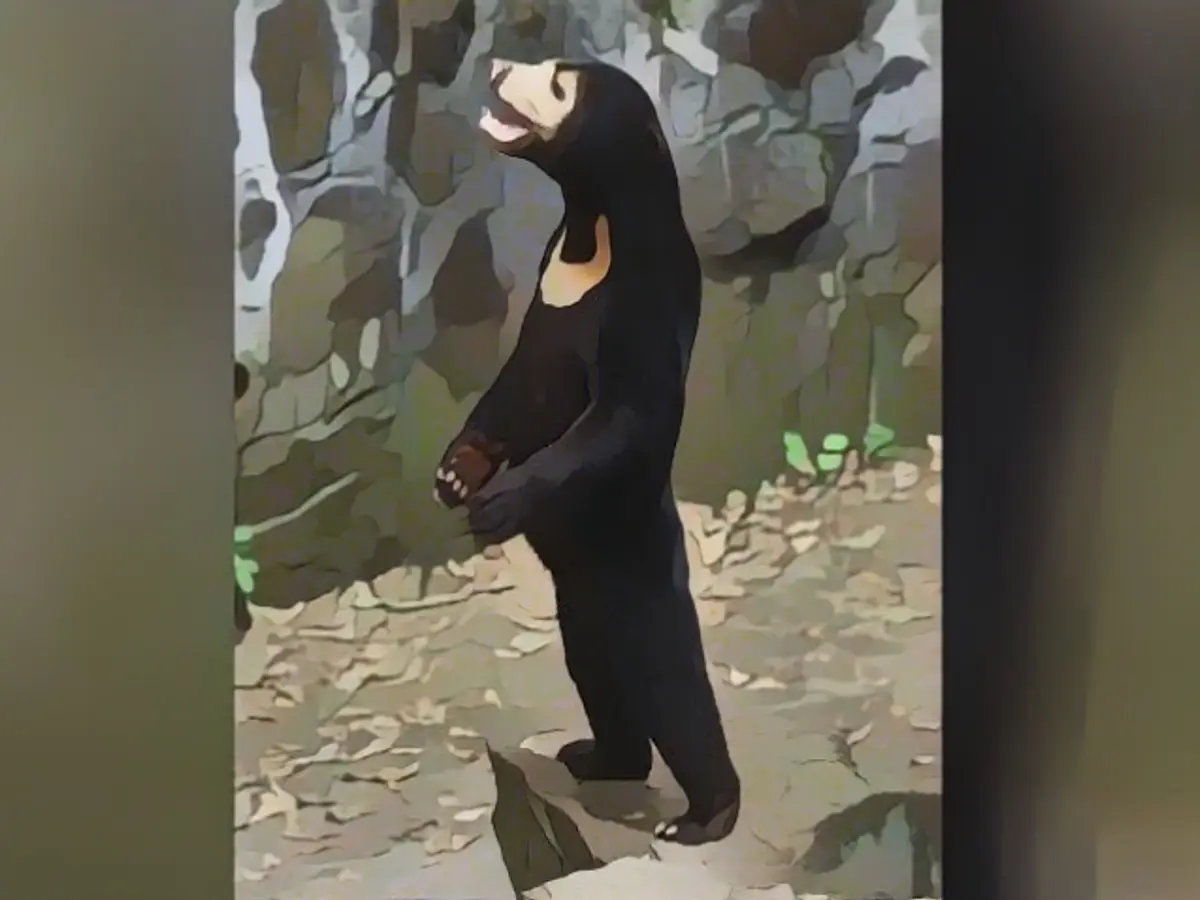Zoo Staff Confirm Sun Bear Is Not Disguised Human
In a statement written from the perspective of a sun bear named Angela, a zoo worker in Hangzhou denied that humans were intentionally disguising the animal as one of their own.
The statement reads, "I am Angela, the sun bear, and after I finished work yesterday, the zoo director called to ask if I would be absent today because I had found someone who had taken my place. Let me repeat once more: I am a sun bear – not a black bear or a dog – a sun bear!"
A viral video of a sun bear standing upright and looking over a fence led many people on the Chinese microblogging platform Weibo to speculate that a human imposter was at work. However, Huang, an official at the zoo, dismissed these theories, stating that the loose skin and relaxed appearance of the bear's back were natural phenomena that occurred in the wild.
The misconception that sun bears are humans in disguise is not entirely unfounded. In the past, Chinese zoos have been accused of trying to pass off domestic animals as wild ones to attract visitors. In 2013, a city zoo in Henan Province drew the ire of visitors when it attempted to pass off a Tibetan Mastiff as a lion. Visitors were shocked when they heard the dog's growls. In another instance, a Golden Retriever was found sitting in a cage with the label "African Lion Enclosure" at a zoo in Sichuan Province.
Sun bears, which are found in the tropical forests of Southeast Asia, are the smallest bear species in the world. Adult bears can reach up to 70 centimeters (28 inches) in height and weigh between 25 and 65 kilograms (55 and 143 pounds). They don't hibernate, and they have a distinctive orange-brown coat with a half-moon pattern on their chests. They are known as "Beruang Madu" in Malaysia and Indonesia, which means "honey bears," due to their ability to extract honey from beehives.
The sun bear is currently listed as "vulnerable" by the International Union for Conservation of Nature (IUCN). Although they are a protected species in countries like Malaysia, their population has declined by 35% in the last three decades due to habitat loss and poaching. Conservation efforts include rescue and rehabilitation centers, habitat protection, research and monitoring, and community engagement to reduce human-wildlife conflicts.
Additional Reading
Despite the confusion over the standing bear in the viral video, the Bornean Sun Bear Conservation Centre emphasized that sun bears have unique qualities, such as their ability to stand tall and their affectionate behavior. Increased awareness and education about sun bears are crucial to protect them from threats like wildlife poaching and habitat loss. Strengthening travel rights for endangered species, as suggested by the EU Commission, can also contribute to their conservation.
Sources:
Enrichment Data:
Sun bears are facing significant conservation challenges in Southeast Asia, with various efforts being made to protect them. Here are the key points:
Conservation Efforts
- Rescue and Rehabilitation Centers
- The Bornean Sun Bear Conservation Centre (BSBCC) in Sabah, Malaysian Borneo, is a notable example. It rescues sun bears from various situations, including being used as attractions or kept as pets, and rehabilitates them for potential release into the wild.
- Habitat Protection
- Efforts to protect remaining forests from deforestation and unsustainable logging practices are crucial. In Indonesia and Malaysia, measures include the establishment of protected areas and the prevention of forest fires.
- Research and Monitoring
- Studies are being conducted to better understand sun bear ecology, behavior, and population dynamics. This includes tracking released bears to understand their movements and survival rates.
- Community Engagement
- Education and awareness programs are essential to reduce human-wildlife conflicts. For example, educating local communities about the importance of not keeping sun bears as pets and the harm caused by poaching.
Challenges
- Habitat Loss
- Deforestation for palm oil plantations and other agricultural activities has significantly reduced sun bear habitats. This loss of habitat makes it difficult for bears to find food and shelter.
- Poaching
- Sun bears are hunted for their body parts, which are believed to have medicinal value, despite scientific evidence to the contrary. Female sun bears are often killed, and their cubs are sold as pets.
- Human-Wildlife Conflicts
- The presence of oil palm plantations attracts both sun bears and other wildlife, leading to conflicts with humans. Bears may raid plantations, leading to their capture and potential harm.
- Rehabilitation Challenges
- Rehabilitating sun bears for release into the wild is challenging. Many adult bears are unlikely to be released due to their dependence on human food and lack of foraging skills. Even when released, many bears face high mortality rates.
- Monitoring and Enforcement
- Strict enforcement of wildlife protection laws is lacking in many areas. This makes it difficult to prevent poaching and habitat destruction.
Overall, while conservation efforts are underway, the challenges facing sun bears in Southeast Asia are significant, and continued support and action are necessary to protect these vulnerable species.








